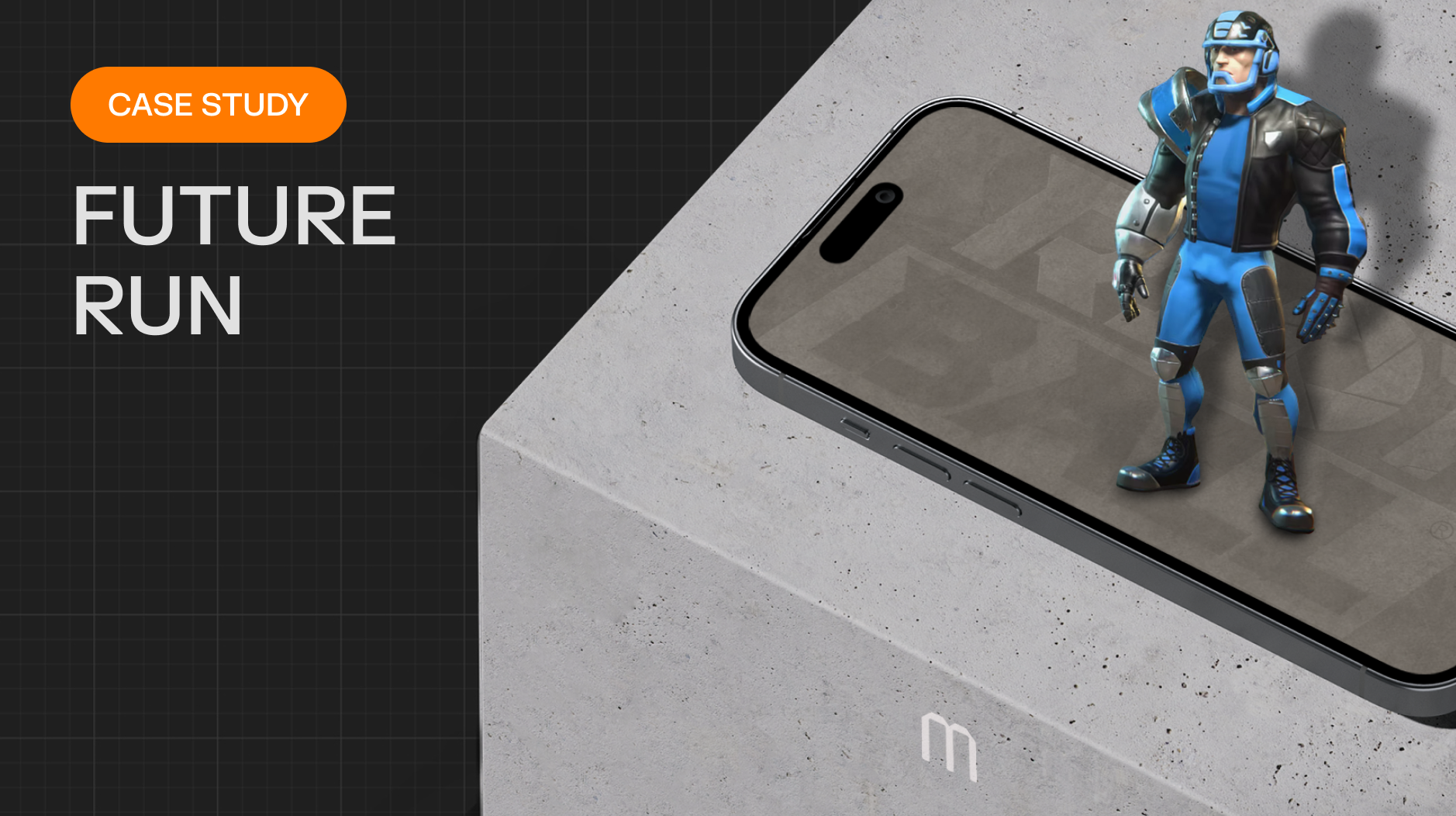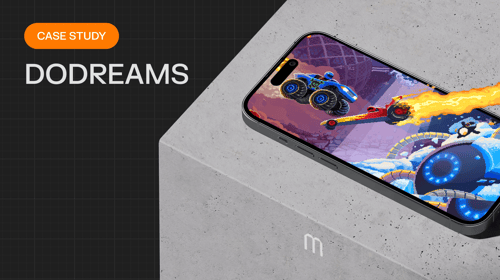
How Future Run is Paving the Way for Real-Time Multiplayer Success with Metaplay

Emil Rosendahl •
Discover how Future Run leveraged Metaplay’s backend platform to refine multiplayer features, build real-time data synchronization, and successfully prepare their debut title, Riot Ball, for its upcoming soft launch across mobile and PC platforms.
Future Run is a Finnish game development studio founded in 2023 by Riku Rakkola, former CEO of Traplight Games, alongside a team of seasoned industry professionals. The studio is dedicated to redefining competitive gaming with high-energy, action-packed experiences that emphasize teamwork and strategy.
Their debut title, Riot Ball, is a cross-platform, team-based PvP sports game set in a dynamic, alternative future. By combining strategic depth with fast-paced gameplay, Riot Ball offers a captivating experience across both mobile and PC platforms.
In 2024, Future Run secured a second round of investment led by Supercell, allowing them to expand their team and accelerate the development of Riot Ball.
Keep reading to find out how Metaplay became their backend solution of choice, streamlining integration and offering the flexibility to customize key features for their ambitious game.
Overcoming the Challenges of Building Multiplayer Infrastructure
Before founding Future Run, Riku and his team had experience building their own backend systems at a previous studio. They were no strangers to the complexities of multiplayer game infrastructure, having had to develop and maintain everything from scratch.
“We had a backend team of about four people, and we built everything ourselves. The biggest challenge was that it took a lot of time,” Riku shared. “We started with the basics to get the game working, and as the project grew, we kept bumping into issues. There were so many features to build, like player sign-in, in-app purchase handling, customer support plugins... it was a huge undertaking.”
Even though the backend infrastructure worked well in the end, it wasn’t scalable enough for future projects. The complexity of managing a growing multiplayer game, with its need for constant updates and real-time synchronization, became overwhelming. Riku explained that as their project scaled up, they needed to think more about the system's scalability. “The time it took to develop and maintain the system was growing. You need to focus on launching the game, not just maintaining a backend forever,” he said.

Choosing Metaplay for Flexibility and Scalability
With Future Run’s goal being to keep the team small while delivering top-tier multiplayer experiences, they knew they needed a solution that would save time without sacrificing control. After evaluating several options, they chose Metaplay.
The decision was driven by two key factors: the scalability and flexibility of Metaplay's platform, combined with the peace of mind that comes with source code access. Riku elaborated, saying, “What really drew us to Metaplay was the fact that everything is delivered as source code. If something happens to the service, we know that we can host it ourselves or adjust things. That level of control and safety is huge for us.”
For a studio like Future Run, having the flexibility to adjust their backend features was crucial. While Metaplay offers a robust out-of-the-box solution, the ability to extend and customize features was key. “If we need something custom, we can build it ourselves without waiting on a large company to implement it. We can develop things fast, and that's what really matters in game development,” Riku explained.
What really drew us to Metaplay was the fact that everything is delivered as source code. If something happens to the service, we know that we can host it ourselves or adjust things. That level of control and safety is huge for us.

Riku Rakkola, Future Run
Customizing Game Features and Ensuring Real-Time Data Synchronization
Metaplay plays a central role in Future Run’s multiplayer framework, particularly in handling the metagame of Riot Ball, which is all about real-time player engagement. Here’s a look at how Metaplay powers some of the game’s most important features:
01 Real-Time Data Synchronization
Since Riot Ball involves constant updates to player data, everything from team resources to in-game stats, Metaplay provides a seamless connection to ensure all players are on the same page. “Metaplay handles the metagame, so all the real-time data, such as team resources, are always up to date across all clients,” Riku said. “With Metaplay’s backend, we can ensure everything is synchronized perfectly, making the game feel more immersive.”
Metaplay’s server-authoritative architecture plays a critical role in ensuring real-time data synchronization. By instantly storing all player actions on the server, Metaplay prevents any possibility of client-side hacks, which can become a major issue as a game scales.
This architecture guarantees that resources and data are always up-to-date across all clients, keeping the game’s state synchronized and secure without the risk of cheating.
02 Custom Features
While Metaplay offers many pre-built features, Future Run frequently customizes them to suit the specific needs of their game. For example, their clan system is heavily customized compared to the out-of-the-box solution. "We built a clan feature that's very different from what Metaplay offers by default, and that’s been incredibly important for us," Riku explained.
The flexibility to build on top of Metaplay’s foundation has allowed Future Run to create a more unique experience for players.
03 Seamless Integration with Photon Quantum
Metaplay’s ability to work in tandem with Photon Quantum has been a key advantage for Future Run. The game uses Photon for the match-side infrastructure, and Metaplay takes care of the metagame and overall player interaction.
Despite the integration complexity, Riku noted that the partnership has been smooth: “We’ve been able to synchronize the two systems with ease, and it’s allowed us to focus on building the fun aspects of the game rather than worrying about the infrastructure.”

Keeping the Team Lean and Focused on Game Development
Without Metaplay, Future Run would have faced a much steeper climb. Riku mentioned that they likely would have needed to look for another backend provider, but building everything in-house was never an ideal option. “If we didn’t have Metaplay, we probably would have gone with another backend service, but honestly, it would have meant expanding our team and taking on a lot more work,” he said.
The benefits of choosing Metaplay go beyond just technical features; it also allows Future Run to focus on their core strengths - game design and player experience. “Without Metaplay, we would have needed a bigger team just to handle the backend, which would have stretched us thin,” Riku reflected. “With Metaplay, we can keep the team lean and stay focused on the game.”
How Metaplay and Photon Quantum Fuel Real-Time Multiplayer Live Service Games
Integrating Metaplay with Photon Quantum to handle different layers of the multiplayer experience has been invaluable for Future Run. The game uses Photon for the real-time match data, while Metaplay handles the persistent, non-real-time features like leaderboards, player progression, and the metagame.
The key challenge here was making sure both systems stayed synchronized. As Riku put it, “The biggest challenge is ensuring that the match data on Photon and the metagame data on Metaplay stay in sync, especially when there’s a disconnect or the match ends unexpectedly. But with Metaplay’s webhook system, we’ve been able to handle it quite well.” Despite the occasional complexity, the integration has allowed Future Run to create a highly cohesive multiplayer experience for players.
Conclusion: Supporting Future Run to Soft Launch and Beyond
Metaplay’s flexibility and scalability have been vital for Future Run as they approach the soft launch of Riot Ball in early August. By providing a robust out-of-the-box solution that Future Run can build upon, Metaplay allows the team to maintain a lean operation while still delivering a high-quality multiplayer experience. The ability to customize features and integrate seamlessly with Photon Quantum ensures that the game is well-prepared for launch and beyond.
As Riot Ball evolves, Metaplay will continue to play a key role in supporting Future Run’s growth. With full source code access and a flexible backend infrastructure, the team can focus on refining the game and adapting to player needs, ensuring that the multiplayer experience remains stable and engaging as the player base expands.
Interested in recreating Future Run's success?
Metaplay Free gives developers everywhere access to the full backend stack for local development, letting you start building ambitious features for your online game from day one.
When it’s time to take your game live and scale with actual players, you'll need to upgrade to Metaplay Pro. That gives you the power to deploy to the Metaplay cloud.
Check out our pricing page for more info on plans, which include development, staging and production environments to fit your development stage.
Sign up for Metaplay Free today and start building with the same tech that's behind some of today's top games.


